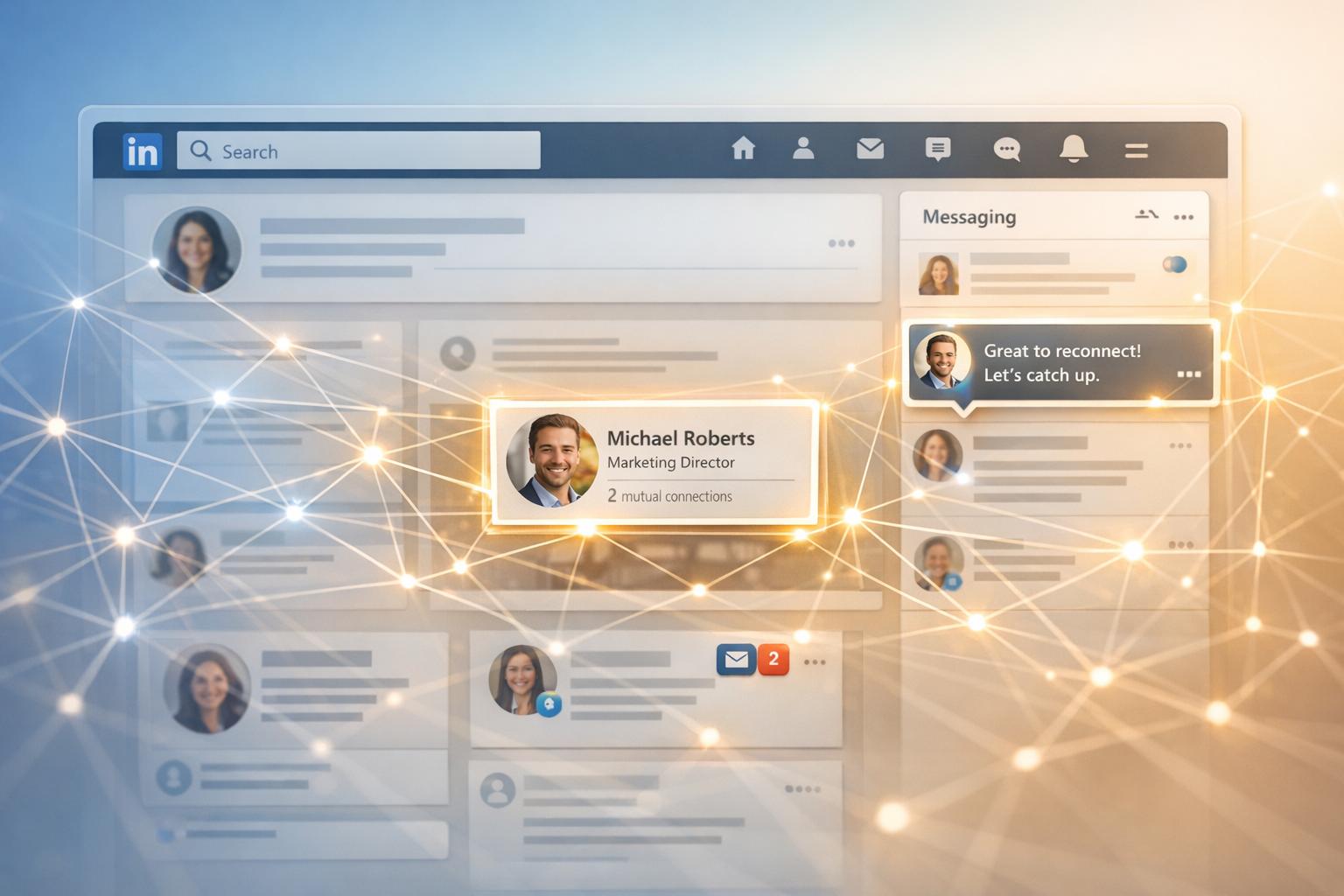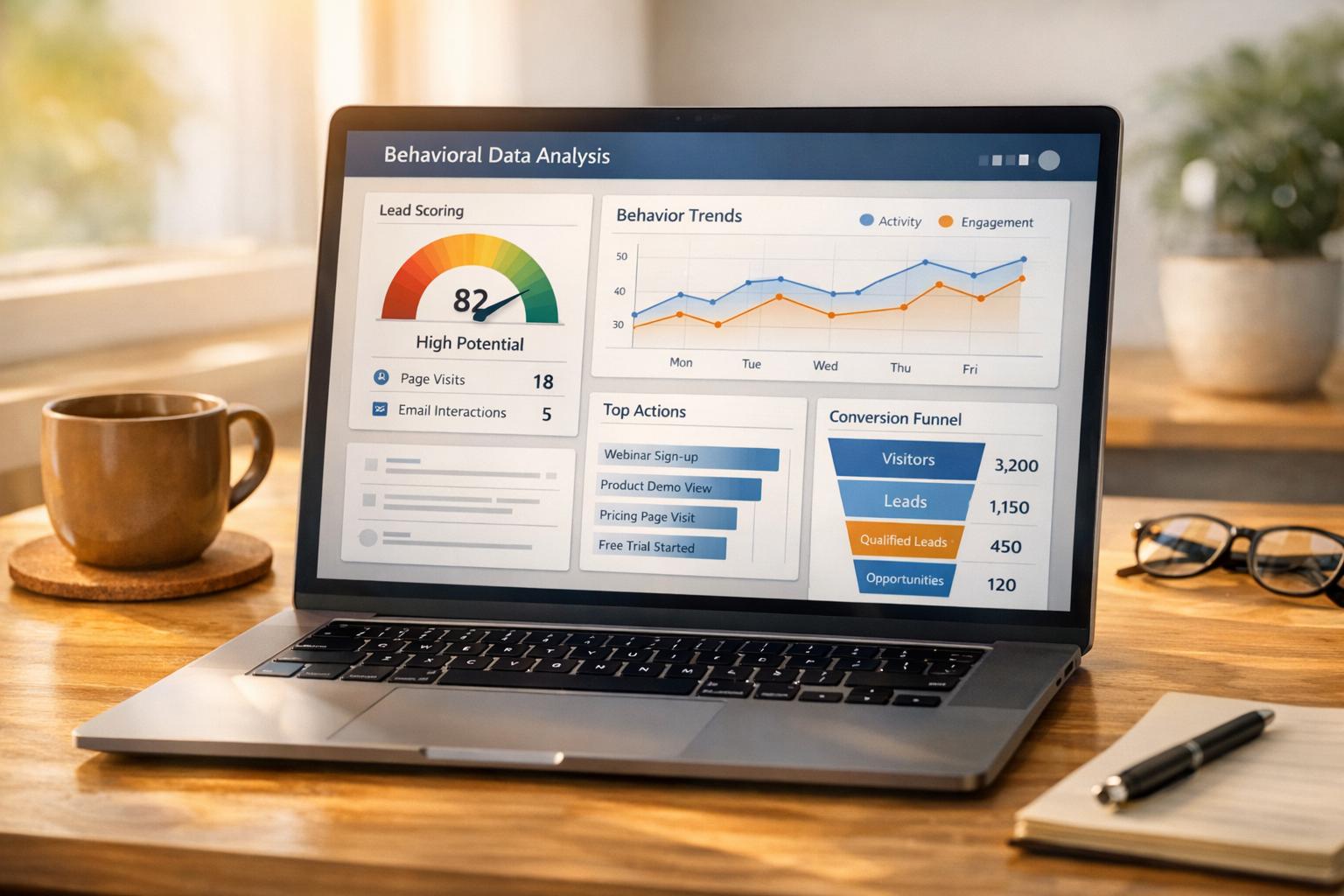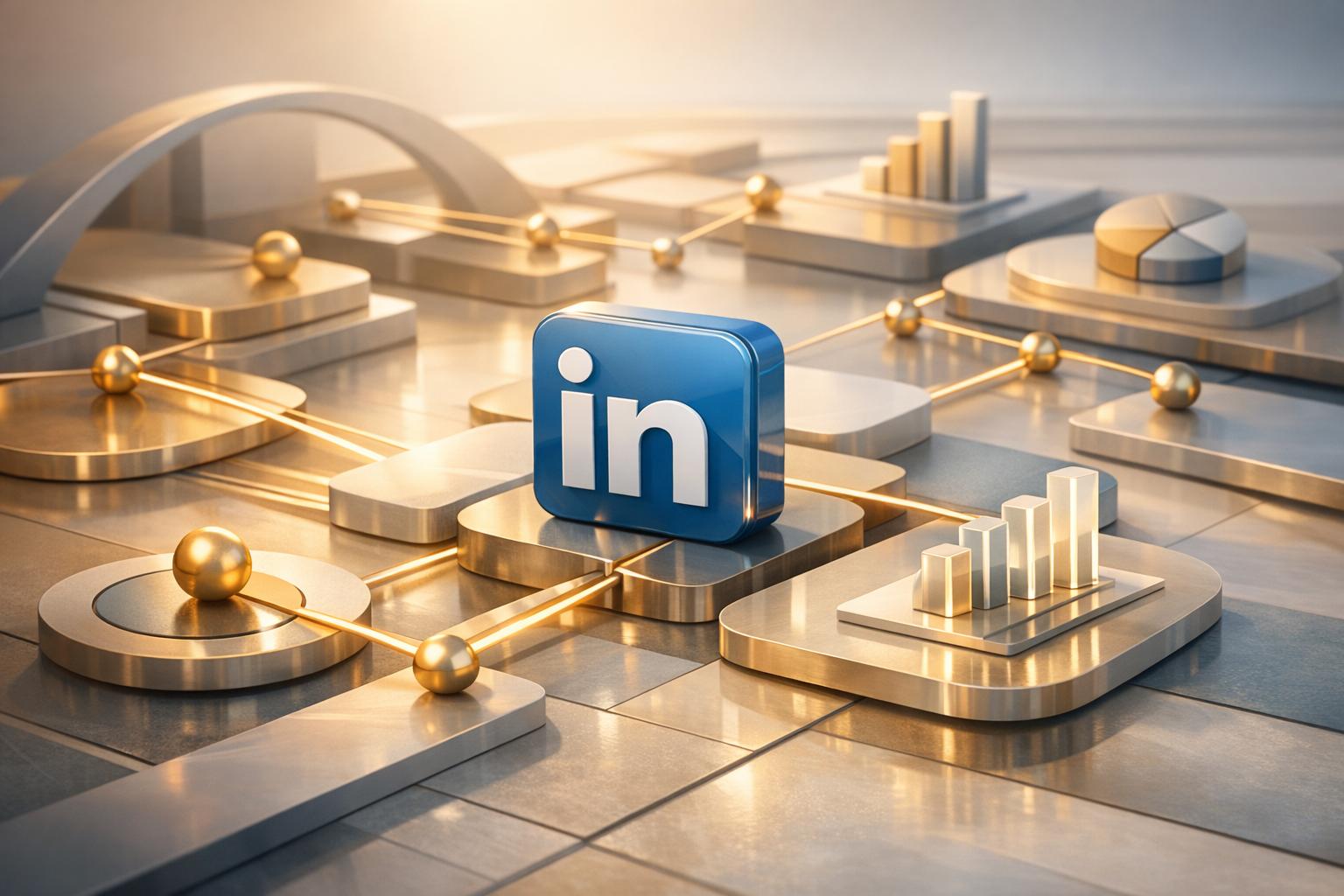
LinkedIn automation tools save time and improve sales outcomes by handling repetitive tasks like prospecting, messaging, and follow-ups. They personalize outreach at scale, prioritize high-quality leads, and integrate seamlessly with CRM systems. Businesses using these tools often report higher response rates, with some generating an average of $100,000 in monthly pipeline value.
Key Benefits:
- Automated Prospecting: AI identifies and filters leads based on profile data and intent signals.
- Personalized Messaging: Tailored outreach crafted from prospect details.
- Lead Scoring: AI ranks leads by engagement and potential.
- Follow-Up Sequences: Automated, behavior-driven follow-ups ensure consistent engagement.
- CRM Integration: Sync LinkedIn interactions with sales tools for streamlined workflows.
- Real-Time Analytics: Track performance and refine campaigns for better results.
By automating LinkedIn sales processes, teams save over 10 hours weekly and manage more prospects without losing personalization. Tools like SalesMind AI make LinkedIn a powerful channel for B2B sales growth.
UPDATED 2025: LinkedIn Sales Navigator Lead Gen with AI & Apollo (Step-by-Step)
Key LinkedIn Automation Features for Sales
LinkedIn automation tools bring together features that simplify every stage of the sales pipeline. They allow teams to expand their outreach while still keeping interactions personal and meaningful.
Automated Lead Sourcing and Prospecting
In the past, finding the right prospects meant spending hours manually combing through LinkedIn profiles. Now, automation tools equipped with AI can handle that heavy lifting. These tools analyze multiple data points to identify and filter high-quality leads that match your ideal customer profile. Instead of wasting time scrolling through endless profiles, sales teams get a refined list of prospects ready for outreach.
What sets advanced tools apart is their ability to go beyond basic filters like job title or location. They can pick up on intent signals - things like recent promotions, company expansion announcements, or increased LinkedIn activity. These indicators help pinpoint prospects who are more likely to be in a buying mindset, allowing teams to focus their energy on leads with real potential instead of casting a wide net.
Once you have this curated list, the next step is reaching out in a way that feels personal, even at scale.
Personalized Messaging at Scale
One of the toughest challenges in sales is keeping outreach personal while reaching a large audience. LinkedIn automation tools solve this by using insights from prospect profiles to create tailored messages automatically.
These tools dig into profile details, recent posts, company updates, and shared connections to craft messages that feel specific and relevant - not like a generic template. For instance, they might highlight a recent achievement or mention a mutual connection, making the outreach feel thoughtful and genuine.
"I've used a couple of other tools for LinkedIn outbound, but this has gotten me 3x the results." - Steven Huibers, COO, Policereports.ai [1]
AI-Powered Lead Qualification and Scoring
Beyond finding prospects, automation tools also help sales teams determine which leads are worth pursuing. AI-powered lead scoring evaluates prospects in real time, considering factors like engagement patterns, company details, and behavior. High-scoring leads are flagged for immediate follow-up, while lower-priority ones are placed into nurturing sequences. This ensures that your team focuses on the most promising opportunities.
Some tools even filter out unqualified leads before they enter your pipeline, saving time and effort [2]. As prospects interact with your content or their circumstances change, their scores are updated automatically, ensuring no sales-ready lead slips through the cracks.
Once leads are scored and prioritized, timely follow-ups become the key to turning interest into action.
Automated Follow-Ups and Engagement
Following up consistently can make or break a deal, but it’s a time-consuming process. Automation simplifies this by creating smart follow-up sequences that adjust based on how prospects respond. These sequences track actions like profile views, content engagement, or visits to your company page, then tweak the timing and messaging to maximize impact.
With AI-powered unified inboxes, sales teams can manage all prospect interactions across multiple LinkedIn accounts in one place. These inboxes offer ready-to-use responses, tagging options, and reminders to keep everything organized. Follow-up sequences might include connection requests, direct messages, content shares, or even profile visits - all designed to maintain engagement throughout the sales cycle.
Together, these features create a powerful sales automation system. Automated lead sourcing fills your pipeline with high-quality prospects, personalized messaging opens doors to meaningful conversations, AI-powered scoring ensures you prioritize the right leads, and smart follow-ups keep prospects engaged. For those who use these tools effectively, the payoff can be substantial, with an average pipeline value of $100,000 per month [1].
How LinkedIn Automation Improves Sales Pipeline Performance
LinkedIn automation is a game-changer for sales teams, streamlining operations by boosting prospect outreach, tracking interactions, and enabling smarter, data-driven decisions. Let’s break down how automation enhances outreach efforts, integrates seamlessly with your CRM, and leverages real-time analytics to refine your sales approach.
Expand Outreach and Boost Response Rates
Manually managing LinkedIn outreach can severely limit how many potential leads your team can contact in a day. Automation tools step in to handle repetitive tasks like identifying prospects, sending connection requests, and crafting initial messages. The result? Sales professionals can save over 10 hours a week while significantly increasing their reach [3].
But it’s not just about quantity. Modern automation platforms use AI to analyze prospect profiles and craft tailored messages that feel personal and relevant. This approach leads to response rates up to three times higher than traditional manual outreach [3]. By combining increased volume with higher-quality interactions, teams can fill their pipelines with qualified leads faster. In fact, some users have reported generating an average pipeline value of $100,000 per month through automated LinkedIn strategies [1].
Seamless CRM and Sales Tool Integration
Automation doesn’t just simplify outreach - it also creates a cohesive sales workflow by integrating with your CRM and other tools. These platforms sync LinkedIn interactions with CRM systems, email, and other sales applications, ensuring that every prospect interaction is tracked and updated in real time [3].
This integration eliminates the common issue of data silos within sales teams. For example, when a prospect replies to a LinkedIn message, that information is automatically updated in the CRM, triggering follow-up actions and updating their lead status. Sales managers can monitor the entire customer journey - from the first LinkedIn connection to closing the deal - right from their CRM dashboard.
Some platforms take it a step further by synchronizing LinkedIn outreach with email, SMS, and social media campaigns. This multichannel approach ensures consistent messaging across all touchpoints, improving lead nurturing and boosting conversion rates as prospects move through the funnel [3].
Centralized data also enhances team collaboration. With all prospect information in one place, sales reps can easily pass leads to colleagues, managers can offer targeted coaching, and marketing teams can refine their strategies based on real engagement insights.
Real-Time Analytics for Smarter Strategies
One of the standout features of LinkedIn automation tools is their ability to provide real-time analytics. These insights, combined with AI-powered lead scoring, help sales teams identify high-potential leads and fine-tune their outreach timing [3].
Teams can analyze which messages generate the best response rates, determine the optimal times to engage prospects, and uncover patterns in how leads interact. Armed with this data, sales teams can continuously refine their campaigns, making adjustments based on what resonates most with their target audience.
"Amazing tool that allowed me to save so much time on my LinkedIn outreach. But that's not all, by automating all conversations and personalizing them with direct insights extracted from my prospect profiles, it gives accurate and high-quality outputs that helped me get more prospect meetings and thus close more deals!" - Sébastien D., Freelance, Freelance Insider [1]
Analytics also shed light on potential bottlenecks in the sales process. Teams can pinpoint where prospects tend to drop off, identify which follow-up strategies are most effective, and evaluate how different messaging styles influence conversion rates. This level of insight empowers sales managers to allocate resources wisely and tweak strategies for maximum impact.
For businesses looking to scale their LinkedIn outreach, these tools shift the focus from reactive problem-solving to proactive campaign optimization. With clear data on what works - and what doesn’t - teams can replicate successful strategies and phase out ineffective ones, driving consistent improvements in sales performance.
sbb-itb-817c6a5
How to Implement LinkedIn Automation in Your Sales Process
Implementing LinkedIn automation effectively requires thoughtful planning and a strategic approach. By following a structured process, you can maximize results while maintaining genuine relationships with your prospects.
Prepare Your Sales Process for Automation
Before diving into automation, it's essential to lay a solid foundation. Start by clearly defining your ideal customer profile (ICP). Analyze your top-performing customers to pinpoint common traits like industry, company size, job titles, and specific challenges they face. Document these details to create a clear blueprint for targeting the right prospects.
Your LinkedIn profile is your digital handshake, so make it count. Use a professional profile photo, craft a headline that communicates your value proposition, and write a summary that addresses your audience's pain points. Sprinkle in relevant keywords and showcase your expertise to build trust and credibility.
Next, prepare your CRM for seamless integration with automation tools. Clean up your contact data, set up lead scoring criteria, and create custom fields to track LinkedIn-specific interactions. This ensures every automated outreach is tracked effectively, and leads can flow smoothly through your sales funnel.
Leverage tools like LinkedIn Sales Navigator to refine your targeting. It allows you to filter prospects based on firmographics and intent signals, helping you zero in on leads with the highest potential. Once your setup is optimized, you can translate it into precise and targeted messaging workflows.
Set Up Your Automated Workflows
With your groundwork complete, it's time to build efficient workflows. Design personalized messaging sequences that gradually build rapport. Start with a connection request message that feels genuine, and follow up with messages that introduce your solution and encourage conversation.
When importing contact lists, ensure your data is accurate and properly formatted. Export leads from your CRM or LinkedIn searches, then upload them into your automation tool using formats like CSV or Excel. Many platforms integrate directly with CRMs like HubSpot or Salesforce, simplifying the process.
Timing is everything. Space out your follow-ups to keep prospects engaged without overwhelming them. Start with intervals of 3–5 days, gradually increasing the time between messages. Each follow-up should add value - share a helpful resource, a relevant case study, or industry insights.
Cloud-based automation tools work around the clock, tracking performance in real time and offering team management features. For businesses running multi-channel campaigns, syncing LinkedIn outreach with email or phone efforts creates a consistent and unified experience that can boost conversion rates.
Monitor and Optimize Your Campaigns
Launching your workflows is just the beginning - ongoing monitoring is crucial to keep them effective. Track metrics like connection acceptance rates, message response rates, and conversions to meetings or demos. Use these insights to refine your approach and identify what resonates most with your audience.
For example, SalesMind AI users report an average connection acceptance rate of 40% and a reply rate of 45%, with some generating an average pipeline value of $100,000 per month [1]. These benchmarks can guide your evaluation and highlight areas for improvement.
Regularly review your analytics to spot trends. If certain messaging templates underperform, test new ones. Adjust your targeting criteria based on which industries or roles show higher engagement.
Modern platforms often include AI features that can supercharge your campaigns. These tools can help with lead scoring, suggesting personalized messages, and making real-time adjustments to your campaigns. Treat automation as an evolving process - let data guide your refinements in messaging, timing, and targeting for better results over time.
Using SalesMind AI for LinkedIn Sales Automation

Once your automation workflows are set up, the next step is choosing a platform that delivers results. SalesMind AI stands out as a powerful tool for B2B sales teams aiming to scale their LinkedIn outreach while keeping it personal and compliant. Here's a closer look at what makes it a game-changer.
SalesMind AI Key Features
SalesMind AI leverages artificial intelligence to simplify and enhance every stage of your sales pipeline. One standout feature is its AI-powered personalized messaging, which analyzes prospect details like job titles, industries, and recent activities. This allows you to send messages tailored to each individual - at scale. It saves time and ensures your outreach feels personal and relevant.
Another major advantage is the unified AI inbox. This consolidates all your LinkedIn interactions - messages, connection requests, and follow-ups - into one easy-to-manage dashboard. The built-in AI co-pilot suggests responses, organizes conversations with tags, and sets reminders, making it easier to handle multiple prospects without losing track.
Advanced lead scoring takes the guesswork out of prioritization. Using AI algorithms, it evaluates prospects based on their engagement, profile details, and past interactions. Combined with automated follow-ups, which trigger sequences based on prospect behavior or preset schedules, this feature ensures leads are nurtured consistently. Together, these tools help sales teams focus on the most promising opportunities while keeping the pipeline active and organized.
These features don’t just simplify the sales process - they also deliver measurable improvements to your overall pipeline performance.
How SalesMind AI Improves Sales Pipelines
SalesMind AI doesn’t just automate tasks; it transforms how sales teams work. By automating time-consuming activities like prospecting and follow-ups, sales professionals can save over 10 hours each week on manual tasks [3]. This means more time for what truly matters: building relationships and closing deals.
"I've used a couple of other tools for LinkedIn outbound, but this has gotten me 3x the results." - Steven Huibers, COO, Policereports.ai [1]
The platform also integrates seamlessly with your existing tools through its CRM integration. This ensures that LinkedIn activities sync effortlessly with your sales systems, maintaining accurate data for reporting and forecasting. Automated workflows tied to CRM updates make it easier to manage your pipeline without jumping between platforms.
With real-time analytics, you gain insights into key metrics like open rates, response rates, and campaign ROI. These insights help identify what’s working, refine your messaging, and allocate resources more effectively to boost performance over time.
Getting Started with SalesMind AI
Getting started with SalesMind AI is straightforward, thanks to its guided setup process. The journey typically begins with a demo or discovery call, where you can explore the platform’s features and receive tailored guidance based on your goals.
The SalesMind AI team provides hands-on support during onboarding. They help connect LinkedIn profiles, configure CRM integrations, and define your target audience. From there, they guide you through creating automated workflows, setting up messaging templates, and establishing lead qualification criteria that align with your sales objectives.
"What really makes them stand out is the support. They didn't just show me how to use the tool; they actually helped me shape my overall marketing approach too. The team is super friendly, quick to respond, and genuinely wants to see you succeed. I always felt like I was getting advice from someone who understood my goals, not just someone reading from a script." - Mark Bahloul, CEO - Software Development, BCome [1]
The onboarding process also includes campaign optimization assistance. The team works with you to fine-tune your messaging and targeting strategies, ensuring you see results from day one without the frustration of trial and error.
Users frequently highlight the platform’s intuitive design and the ease of implementation. Whether your team is tech-savvy or new to automation, SalesMind AI’s combination of a user-friendly interface and dedicated support makes it accessible and effective for everyone.
Transform Your Sales Pipeline with LinkedIn Automation
LinkedIn automation has become a game-changer for modern sales teams. The numbers back it up - businesses using SalesMind AI are seeing improvements across every stage of their sales pipeline. Let’s break down the key advantages and explore how you can seamlessly integrate automation into your process.
Key Benefits Summary
Automation delivers measurable benefits like saving time, boosting response rates, and increasing monthly pipeline value. These enhancements not only improve efficiency but also highlight the strategic advantages discussed earlier.
On top of the metrics, automation simplifies sales operations. Features like the unified inbox bring all LinkedIn interactions into one easy-to-manage dashboard, while AI-powered lead scoring ensures you focus on the most promising opportunities. This organized approach reduces the chaos of juggling multiple conversations and helps prevent valuable leads from slipping through the cracks.
Next Steps for Your Business
Ready to take advantage of these benefits? Here’s how to launch and optimize your LinkedIn automation strategy. As mentioned earlier, automation can enhance every phase of your sales pipeline - these steps will help you unlock its full potential.
Start by identifying the areas where your team spends the most time - whether it’s prospecting, follow-ups, or qualifying leads. Pinpointing these bottlenecks will shape your automation plan and provide a benchmark for measuring success.
Consider booking a demo or consultation with SalesMind AI to see how their platform can address your specific needs. Their team offers straightforward setup and support, making it easy even for those new to automation.
"SalesMind AI has elevated my LinkedIn experience, offering exceptional customer service to maximize the impact of their product. Their team not only assisted with implementation but also provided insights to fine-tune my campaigns, enhance my profile's appeal, and boost lead acquisition. The tangible results in terms of high-quality leads and business growth speak volumes. SalesMind AI is not just a tool but a dedicated partner in achieving success on LinkedIn. Highly recommended for anyone looking to maximize their LinkedIn potential."
– Bennett Newhook, Founder, Outport - Marketing Services [1]
When launching your campaigns, prioritize quality over quantity. Focus on well-defined target audiences and craft personalized messaging templates. As you collect data and fine-tune your strategy, you can gradually scale your outreach without sacrificing the personal touch that drives engagement.
Finally, remember that automation isn’t a “set-it-and-forget-it” tool. Regularly analyze your results, experiment with new messaging strategies, and adjust your targeting based on performance data. The best teams treat automation as a dynamic system that evolves over time.
Transforming your sales pipeline starts with taking that first step. Whether your goal is to save time, improve response rates, or expand your outreach, LinkedIn automation provides a strong foundation for sustainable growth in today’s competitive B2B market.
FAQs
How does LinkedIn automation help maintain effective personalization at scale?
LinkedIn automation tools, such as those from SalesMind AI, make personalization a breeze by using AI to create messages that fit each prospect's specific business situation and communication style. This way, even when reaching out to a large audience, your messages feel relevant and authentic.
Some standout features include automated personalized messaging, smart lead qualification, and intelligent follow-ups. These tools help businesses expand their outreach efforts while keeping interactions personal, making it simpler to form genuine connections and boost sales results.
What should you consider when connecting LinkedIn automation tools to your CRM?
When combining LinkedIn automation tools with your CRM, it's crucial to ensure they function smoothly together to prevent any workflow hiccups. Key features to prioritize include automated data syncing, which updates your CRM with real-time lead details, and personalized messaging automation to make outreach more efficient.
A tool like SalesMind AI makes this integration easier by automating tasks such as lead qualification and follow-ups. This allows your sales team to concentrate on building meaningful connections while the software takes care of the repetitive, time-consuming tasks in the background.
What are the best ways to evaluate the success of LinkedIn automation for improving sales pipelines?
To measure how well LinkedIn automation is working in your sales process, keep an eye on a few key metrics. These include connection acceptance rates, response rates, and how it influences lead generation and the progression of deals.
Tools like SalesMind AI make this easier by offering detailed analytics and actionable insights. By tracking these numbers, businesses can pinpoint what’s effective, adjust their outreach strategies, and ensure their efforts lead to tangible results.


.avif)


